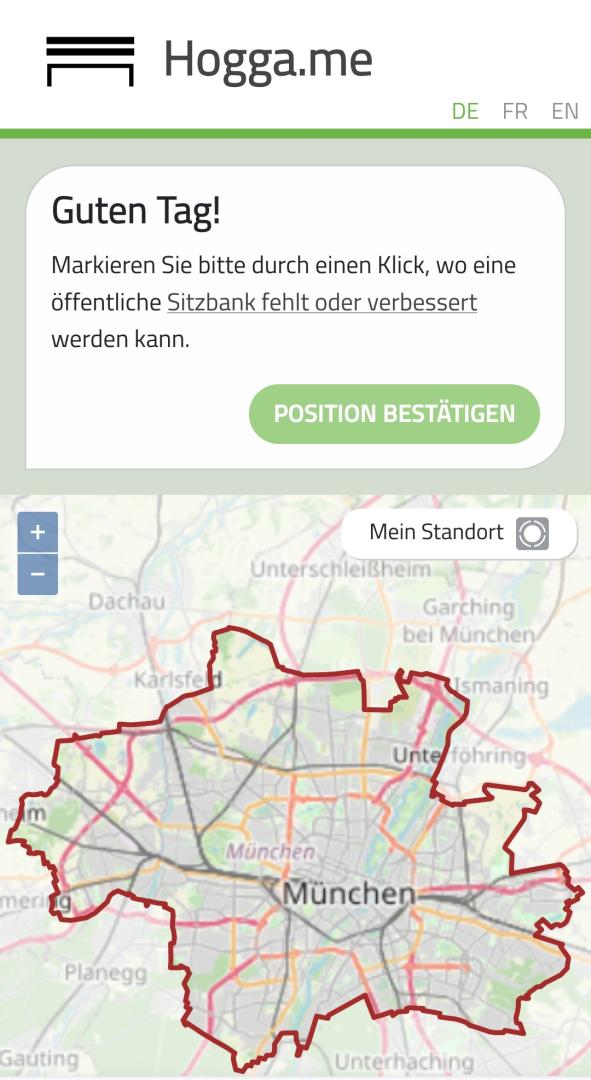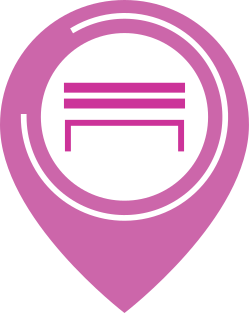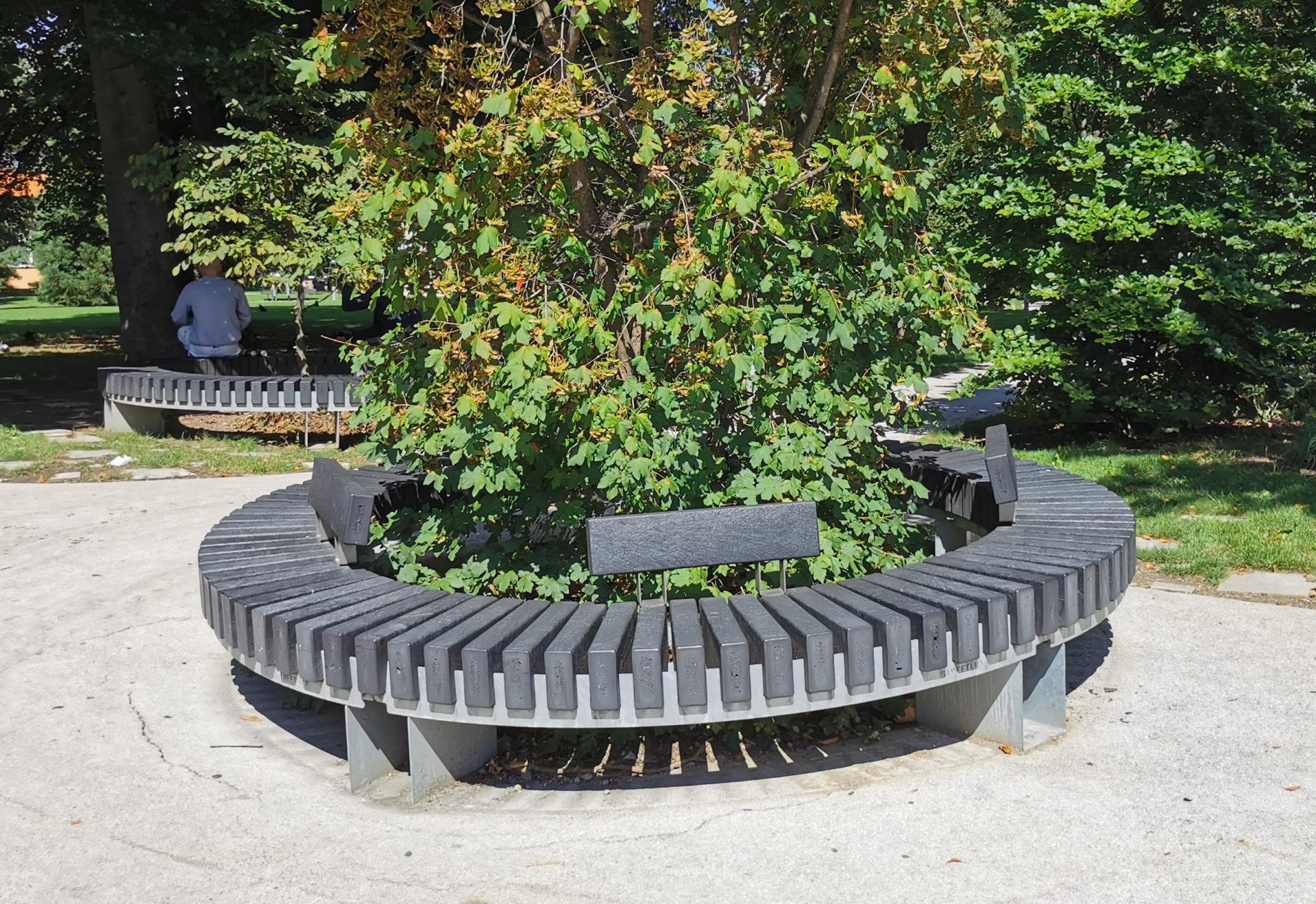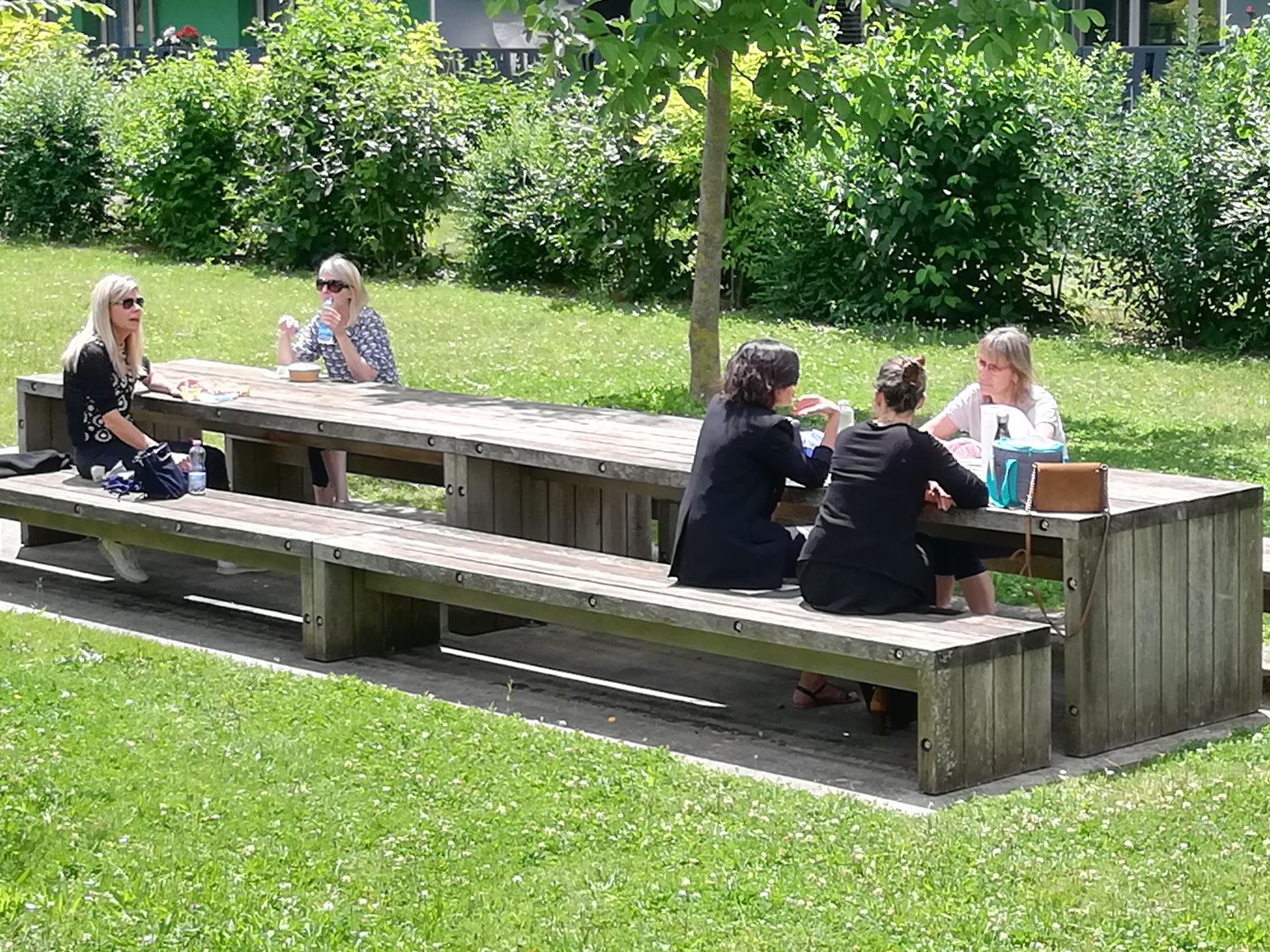hogga.me
Basic information
Project Title
Full project title
Category
Project Description
The public bench represents a close practical and emotional link between the city and its citizens. It is a key element for urban well-being and as "service station for pedestrians" it facilitates active mobility. However, the equipment of public space with benches is often decided without the participation of the users. hogga.me allows all citizens to describe and share their seating needs and preferences in a low-threshold way. It is especially aimed at people with special seating needs.
Geographical Scope
Project Region
Urban or rural issues
Physical or other transformations
EU Programme or fund
Which funds
Description of the project
Summary
Hogga.me is a method and online-web-application for citizen engagement on public benches. It empowers citizens and creates spatial awareness, increases knowledge and connects stakeholders; it allows involvement in the ideation process and promotes emotional ownership and advocacy.
Public benches are not only service stations for pedestrians, facilitating active mobility. They impact citizens’ quality of life on an individual and community level, offering a place to rest, to work, to meet and to create a sense of belonging. Well designed and placed benches bring people together, also of different ages or cultural background. They increase the “familiarity” of places and people, give meaning and spirit to places and allow to reconnect with nature.
But decisions on public benches are usually made within the triangle of producers, urban deciders and architects – representing usually a leisure-oriented user group. The end users are not part of this decision-making process. The general knowledge about the impact of material, shape or positioning of benches on users and uses is weak.
The real experts on seating needs, preferences or obstacles for the use of benches are bench users. Therefore, the citizen engagement method “hogga.me” addresses them directly. It enables all user groups to describe and share their seating needs through a low-threshold but structured practice. Hogga.me addresses particularly those who have special seating needs but fewer possibilities to express them in the official decision-making processes.
A web-application allows participants to locate missing benches or to propose improvements for existing ones. It is accessible with any browser and each device. Participants can answer further questions on this bench and their general preferences, guided by a questionnaire in chat-style.
The project allows cities to better understand the variety of local seating needs and restrictions – a first step to adapting the offer of public seating devices.
Key objectives for sustainability
The objective of this project is to help cities to adapt public seating devices to the variety of needs of all user groups and to enable benches to best fulfil their integrative and health functions for society, for a district and neighbourhood in a dynamic way.
Another main objective of this project is the initialisation of a paradigm shift from the bench as design object, as “signature” of the architect or urbanist to the bench as service for mobility and hospitality. Better chosen and positioned benches will stimulate a behavioural change towards active and public modes of transport, contribute to the reduction of carbon use and the mitigation of climate change. They increase the accessibility and sojourn quality in public spaces for all user groups and therefore the competitiveness of cities.
This project aims to reduce inappropriate seating accommodations and their negative consequences on the life quality of citizens. Subtle exclusion of user groups, conflicts of use and interest can be identified, measures for mitigation can be taken.
This project also aims to increase the awareness on the importance of engaging of citizens and allows everybody to get involved in an easy, low-threshold manner.
These objectives have been met by the pilot project concerning the awareness, the accessibility of the tool, the expression of different needs and preferences of different user groups. The impact on physical changes cannot yet be measured, as the report was transmitted only in February. However, the discussion triggered – in professional circles, city administration, in user groups – shows, that a new, sensitive - and now measurable - topic is on the table and solutions are asked for.
This project also serves research by sharing the (anonymous) data. The accumulated data allows identifying user typologies and developing new, user-oriented solutions on forms, materials, functions, positioning of benches in cooperation with bench producers, architects and planners.
Key objectives for aesthetics and quality
Intuitive handling was central: Three clicks are sufficient to declare a bench proposition (first click: get located on the map; second click: chose the topic; third click: submit). Further questions are asked in a chat-style, offering pre-formulated answers and a text field. The questionnaire is structured in three short parts and can be quit at any time.
People with special needs for benches have been addressed as close as possible: 500 local associations, dedicated to criteria indicating frequent or special bench uses (age, illness, accompanying persons, parents, migrants, etc.) have been identified and contacted. Communication also included integration in existing events, local Facebook-groups or media. Without communication budget, close to 3’000 people opened the web app and 373 propositions have been declared within 3 months. Participants have clearly more difficult and complex requirements for public space than average.
Another objective was to motivate participants to answer as many questions as possible and to get them to re-use the application. More than a quarter of the participants registered several benches and more than a third answered all questions.
In order to make the website easier to remember, the chosen domain name - muenchen.hogga.me – refers to the local dialect ("sit down"). As during the pandemic the use of QR codes was widely acquired in Munich, a branded QR code was created.
Key objectives for inclusion
Decision makers in cities are often those citizens who use public seating the least: Healthy full-time-working man with no care responsibilities. Therefore, policies a for public accommodation tend to be a mirror of their personal lifestyle and preferences, like the bench as design object, as identity tools for the city or as the signature of the architect. This leads to a subtle exclusion of vulnerable user groups, e.g. with care activities, health problems, special needs for public seating or newly arrived inhabitants.
This project aims to allow all inhabitants - also and especially those with no or few representations among the decision-making stakeholders - to express and describe their individual seating needs in a structured, but still open and easy way.
The pilot project showed that participants were effectively above average female, 35–60 years old and with difficult walking conditions, i.e. special needs for benches. Several contributions were made in the name of elderly people who could not participate themselves.
The results help the city to understand the diversity and bandwidth of seating needs, but also sociability and mobility needs, constraints and preference. This understanding as well as voluntarily shared contact details allow developing solutions in co-design, but also to relate seating needs to the city’s morphology, traffic situation and the localisation of points of interest of daily life. It helps cities to develop an urban seating concept, aiming to increase the number of benches and individual seating choices in public space, between e.g. temporary privacy and social contact, passive or active immersion in urban life, enjoyment of the sun or shade, etc.
Improvements of public seating devices increase the accessibility and possibility of appropriation of public space for all user groups. Benches foster active and inclusive mobility and reduce the subtle depriving of user groups from public space, fresh air and urban life.
Results in relation to category
The pilot project in Munich – without any communication budget – had 2,921 direct visits within 3 months’ time. A total of 259 people recorded 373 contributions, which are propositions for new benches and improvements to existing benches.
It was mostly women (70%) who responded to the communication measures for this citizen participation project. Users in the age of 26 to 60 where over-represented, but they repeatedly proposed improvements of benches for other people with special needs, the users thus acted as an agency for others with difficult walking conditions.
An above-average number of participants has to cope with a particularly challenging walking situation, compared to another study of urban pedestrians by EPFL-LaSUR. This means, they usually carry loads or walk in groups, accompany children or people who cannot walk easily or have permanent or temporary problems with walking or just need a bench to be able to walk.
Close to 20 % of the participants communicated their email address in order to be invited also for future testing of benches or citizen lab activities.
This confirms the hypothesis of this project, which assumes that people with special needs for walking and seating will appreciate and use this kind of simple, low-threshold possibility in order to share and describe there needs for public benches and the shortcomings of the existing offer. This project helps to understand the variety of seating needs and allows to include them in the co-creation process as well as in the design of an inclusive, accessible public realm.
How Citizens benefit
Involvement in the design: This project is the outcome of four years of formal and informal observation of bench users, like people with illnesses, mobility constraints, elderly people, healthy and young people. Dozens of discussions and interviews have been held with bench producers, city planers, engineers and city administration. They gave an idea of general shortcomings in the conception of benches, their production, installation, infrastructure and localisation. We stated that end user's motivation, criteria and activities are rarely known to them, as well as the variety of their needs and preferences. Therefore, all these criteria have not been included in the the choice of shapes, materials, placement, density of benches, bench users are no stakeholders in this decision making process.
Involvement in the implementation: hogga.me is a citizen engagement project, which targets an inclusive involvement of citizens and the civil society is the core of this project. Traditional citizen engagement projects often exclude certain groups, e.g. those who do not dare to speak in public, those who cannot come to an event held in the evening or during a full day, or those who are just not able to walk in a city without sufficient benches.
The benefit of this citizen-oriented approach lies in the design of the project. Every detail aims to enable and motivate those, who we have identified as having special needs on public space and less possibilities to express them: The communication measures, the design of the Web site, the domain name, the user interface (colours, design as chats), as well as the questions. They derive from previous studies, and add topics of which deciders are rarely aware of. Many users have not yet verbalised or reflected on them, like distance, gaze, although we know their influence. The gratefulness of participants and the very positive feedback allow to conclude that there is a real need for this kind of citizen engagement for public seating.
Physical or other transformations
Innovative character
Currently, decisions about the installation of benches are made in the triangle of architect, bench producer and client – which is usually a municipality or city. Interviews with responsible decision-makers of these stakeholders revealed that the general knowledge on users, uses, activities, preferences and needs is weak and that closing the knowledge gaps would be appreciated. Research in the last decades was concentrated on generic needs of elderly people. But depending on size and constraints of body as well as special needs, preferences and constraints, some of them are still excluded from the use of benches.
Therefore, the actual practise concerning the choice of form and material and the placement of benches follows more or less pragmatic considerations (maintenance, servicing, storage, spare parts, vandalism, etc.) or questions of style, recognition value or simply the desire for a personal signature of the urbanist or architect.
This project is a new, innovative but simple and low-threshold solution which allows to address the specific seating needs of all citizens, but especially to those who are particularly vulnerable or have special requirements for public space in order to be able to use it, and to do so in a safe and efficient manner. It allows also to better understand the interdependency between benches, bench-users, the direct environment and infrastructure of bench-places as well as to the topography and morphology of a city and the points of interest of daily life.
The project team is not aware of any alternative projects which allow in a similarly simple way to systematically collect needs, preferences, constraints, obstacles of different groups of bench users, which allows by its geo localisation to incorporate them into the planning. In this respect, this project is unique, disruptive and innovative, although it does not feature any special technical inventions.
Learning transferred to other parties
Both outputs, the web app and the method for citizen participation are easily transferable and scalable. They can be applied at any level, to cities, regions, countries or to small villages, rural areas, shrinking cities, degenerated city districts and de-industrialised areas. The web tool already exists in 4 languages and can easily be adapted to other languages.
For each new "seat-izen" engagement project, a corresponding subdomain will be created - e.g. wien.hogga.me. The map on the entry page will be centred on the corresponding area and some small parameters have to be adapted. The project can be communicated to the concerned citizens or guests, contributions can be followed on an analytical interface (accessible only for the project team). The learning experience from the pilot project in Munich allows to better plan and target communications measures in a way to include and enable particularly population groups known for their particular needs for benches. This learnings will be part of new trainings and courses which are developed in the follow-up project (EIT urban mobility, KAVA 21164 SEATING).
This simple method allows breaking down global knowledge to local particularities, and vice versa. Each city can thus better understand the diversity of needs and preferences of its local user groups and react on the geo-located suggestions for improvement for benches. Statements on the preferences or problems concerning the shape and material of the current models of benches, their density or orientation can easily be generalised for the whole city. Generated data are shared with a research facility (EPFL), which allows identifying typical users, uses and conflicts, developing new (interdisciplinary) solutions and enlarging the still very limited standard knowledge on public seating. Complementary research activities are ongoing. All results together will lead to a toolbox for urban seating concepts.





